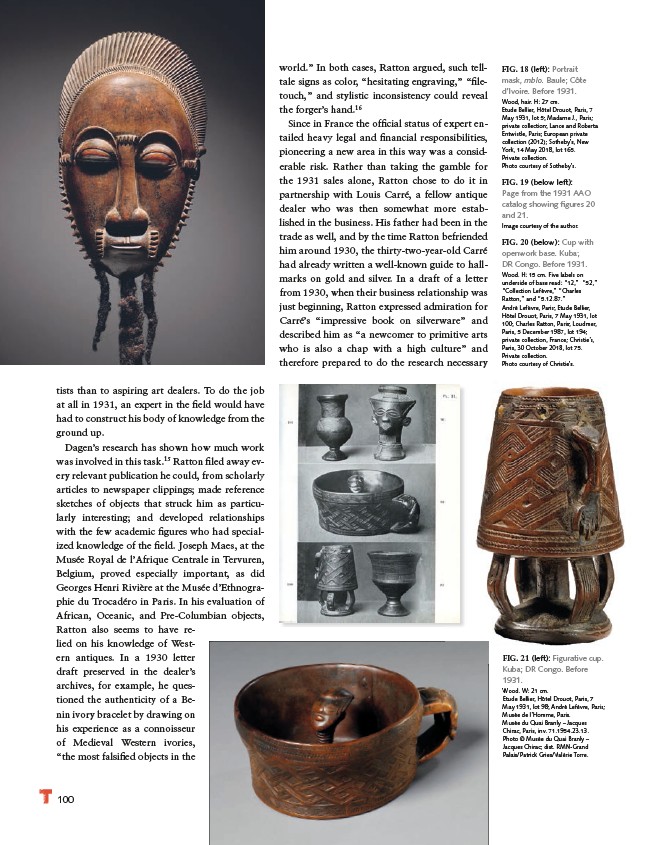
PORTFOLIO
100
world.” In both cases, Ratton argued, such telltale
signs as color, “hesitating engraving,” “fi letouch,”
and stylistic inconsistency could reveal
the forger’s hand.16
Since in France the offi cial status of expert entailed
heavy legal and fi nancial responsibilities,
pioneering a new area in this way was a considerable
risk. Rather than taking the gamble for
the 1931 sales alone, Ratton chose to do it in
partnership with Louis Carré, a fellow antique
dealer who was then somewhat more established
in the business. His father had been in the
trade as well, and by the time Ratton befriended
him around 1930, the thirty-two-year-old Carré
had already written a well-known guide to hallmarks
on gold and silver. In a draft of a letter
from 1930, when their business relationship was
just beginning, Ratton expressed admiration for
Carré’s “impressive book on silverware” and
described him as “a newcomer to primitive arts
who is also a chap with a high culture” and
therefore prepared to do the research necessary
FIG. 18 (left): Portrait
mask, mblo. Baule; Côte
d’Ivoire. Before 1931.
Wood, hair. H: 27 cm.
Étude Bellier, Hôtel Drouot, Paris, 7
May 1931, lot 5; Madame J., Paris;
private collection; Lance and Roberta
Entwistle, Paris; European private
collection (2012); Sotheby’s, New
York, 14 May 2018, lot 165.
Private collection.
Photo courtesy of Sotheby’s.
FIG. 19 (below left):
Page from the 1931 AAO
catalog showing fi gures 20
and 21.
Image courtesy of the author.
FIG. 20 (below): Cup with
openwork base. Kuba;
DR Congo. Before 1931.
Wood. H: 15 cm. Five labels on
underside of base read: “12,” “52,”
“Collection Lefèvre,” “Charles
Ratton,” and “5.12.87.”
André Lefèvre, Paris; Étude Bellier,
Hôtel Drouot, Paris, 7 May 1931, lot
100; Charles Ratton, Paris; Loudmer,
Paris, 5 December 1987, lot 194;
private collection, France; Christie’s,
Paris, 30 October 2018, lot 75.
Private collection.
Photo courtesy of Christie’s.
FIG. 21 (left): Figurative cup.
Kuba; DR Congo. Before
1931.
Wood. W: 21 cm.
Étude Bellier, Hôtel Drouot, Paris, 7
May 1931, lot 98; André Lefèvre, Paris;
Musée de l’Homme, Paris.
Musée du Quai Branly – Jacques
Chirac, Paris, inv. 71.1954.23.13.
Photo © Musée du Quai Branly –
Jacques Chirac; dist. RMN-Grand
Palais/Patrick Gries/Valérie Torre.
tists than to aspiring art dealers. To do the job
at all in 1931, an expert in the fi eld would have
had to construct his body of knowledge from the
ground up.
Dagen’s research has shown how much work
was involved in this task.15 Ratton fi led away every
relevant publication he could, from scholarly
articles to newspaper clippings; made reference
sketches of objects that struck him as particularly
interesting; and developed relationships
with the few academic fi gures who had specialized
knowledge of the fi eld. Joseph Maes, at the
Musée Royal de l’Afrique Centrale in Tervuren,
Belgium, proved especially important, as did
Georges Henri Rivière at the Musée d’Ethnographie
du Trocadéro in Paris. In his evaluation of
African, Oceanic, and Pre-Columbian objects,
Ratton also seems to have relied
on his knowledge of Western
antiques. In a 1930 letter
draft preserved in the dealer’s
archives, for example, he questioned
the authenticity of a Benin
ivory bracelet by drawing on
his experience as a connoisseur
of Medieval Western ivories,
“the most falsifi ed objects in the